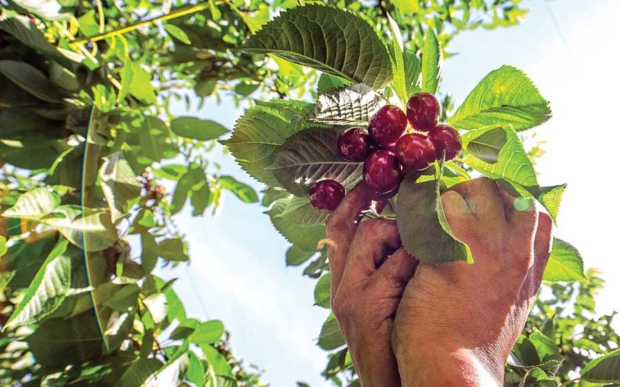
Gonzalo Villareal harvests SweetHeart cherries in Selah, Wash., on July 16, 2015. (TJ Mullinax/Good Fruit Grower)
After record-setting heat in 2015, cherry growers look to new year.
Another Northwest cherry season is around the corner, and at this point, there is no reason not to expect another 20 million box crop of amazing sweet cherries!
Our cherry growing cohorts in California are reporting the best chilling hours and best southern district bloom and set that they have seen in five years.
The California crop is running ahead of normal by four or five days, and experts suggest that a crop of 6 to 7 million 18-pound equivalent boxes is a realistic estimate at this point.
The Californians are predicting enough cherries for Memorial Day promotions and very limited crossover into June.
The Northwest, meanwhile, is planning for large Fourth of July promotions and hoping that the entire country has “summer weather” during that holiday weekend.
Being in the sweet cherry business, we all know that no season ever seems to play out the same. Every season is about high hopes for a unique and truly outstanding product.
But every season seems to have different nuances and issues that come into play. From the orchard to the market, we work hard to cultivate opportunity for success. Likewise, everyone in the Northwest hopes that 2016 will be the season where everything goes right from start to finish.
The 2015 season came and went like a whirlwind. Shipments started in late May and were all but done by the first week of August.
The quick and compressed season constitutes the earliest finish for the Northwest in over 20 years. It appears that the total Northwest fresh crop came in at 19.4 million 20-pound equivalent boxes.
The 2015 crop started early (on May 23) and compressed to 18.5 million boxes being shipped over just 60 days.
Likewise, the Round 1 crop estimate that was distributed to the industry on May 4, 2015, came in at 19.6 million boxes; that means that by season’s end, the industry estimate was accurate within 1.5 percent.
In the preseason, the industry saw a clearly defined separation between the end of the Bing crop and the beginning of the Skeena and Lapin harvest.
The hottest June in history pushed the late crop forward and the gap our industry sales organizations expected to have between Bings and the Canadian varieties never developed, causing some panic across the industry.
Likewise, it is important to note that during the week of June 26, the estimate lagged behind actual shipments by over 1 million boxes (and incoming receipts were much, much higher).
Why? In a word: heat.
June was a record-setting month.
The industry shipped an all-time record 11.8 million boxes in June and 14 million by July 4. As every cherry grower knows, we also saw the hottest June on record.
In the words of Nic Lloyd at Washington State University’s AgWeatherNet, “June 2015 here in the Northwest is in a class of its own in terms of temperatures.” Statistically speaking, Lloyd said, June was at least a one in 400-year event.
Those conditions were challenging both in the orchard and in the market. We saw unprecedented demand for our fruit from the beginning of the season through July 4.
The two weeks following July 4 saw the industry struggle to move fruit as quickly as the compressed harvest demanded. For the first time, we saw Bings, Rainiers, Lapins, Skeena, Regina and Sweethearts being harvested at the same elevations all at the same time.
Here is a quick look at the 2015 season by the numbers:
—May fresh shipments were just over 400,000 boxes, a Northwest record.
—The industry shipped for 77 days in 2015 — averaging 266,000 boxes per day — compared to 84 days in 2014, 81 days in 2013 and 92 days in 2012.
—The industry shipped over 400,000 boxes per day for 23 days in 2015, and over 500,000 boxes per day for 11 days.
—The largest shipment day was June 25 at 594,744 boxes.
—The Rainier cherry pack was 1.7 million 15-pound equivalent boxes vs. 2.1 million 15-pound equivalent boxes in 2014.
—Seventy percent of the crop went to the domestic market, and 30 percent to exports.
—California finished shipping on June 8 and shipped 5.9 million 18-pound equivalent boxes.
I know that this information does not offer any magic remedies, but I hope it at least gives our growers some further insight.
I do not think the late season is doomed over the long haul; it has been on the short end of unstable market dynamics the past two years.
Growers are adamant that weather trends are cyclic, and the current cycle has been harder on the late growers and on our late varieties.
While I believe the entire industry is better off with an early start that allows for ample shelf space for the July 4 holiday, the sustained heat of over 100 degrees changes the playing field for growers, sales organizations and domestic and export markets. •
– by B.J. Thurlby, president of Northwest Cherries.






Leave A Comment